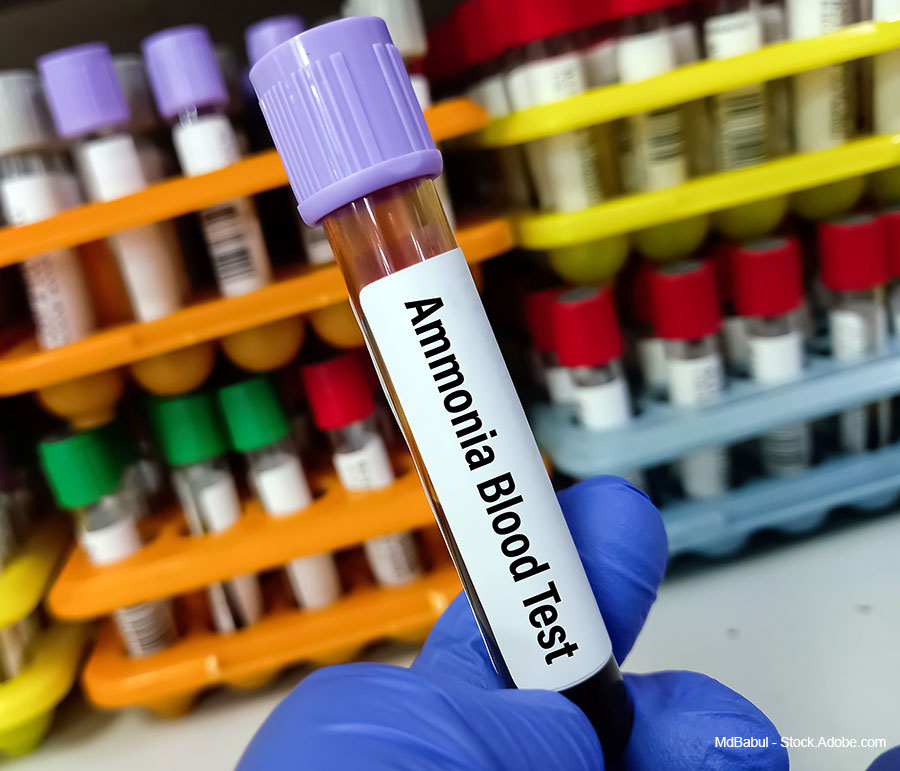 A 77-year-old woman with a history of hepatitis C cirrhosis presents to the emergency department with 24 hours of progressive confusion and disorientation. The physical exam is notable for fluctuating levels of consciousness, disorientation to time and place, asterixis, brisk deep tendon reflexes, and a positive fluid wave. Labs were notable for AST 85 IU/L (normal, 10 to 40 IU/L), ALT 70 IU/L (normal, 7 to 56 IU/L), and total bilirubin 2.5 mg/dL (normal, 0.1 to 1.2) mg/dL. Ammonia level was elevated at 160 µmol/L (normal, 15 to 45 µmol/L).
A 77-year-old woman with a history of hepatitis C cirrhosis presents to the emergency department with 24 hours of progressive confusion and disorientation. The physical exam is notable for fluctuating levels of consciousness, disorientation to time and place, asterixis, brisk deep tendon reflexes, and a positive fluid wave. Labs were notable for AST 85 IU/L (normal, 10 to 40 IU/L), ALT 70 IU/L (normal, 7 to 56 IU/L), and total bilirubin 2.5 mg/dL (normal, 0.1 to 1.2) mg/dL. Ammonia level was elevated at 160 µmol/L (normal, 15 to 45 µmol/L).
Brief overview
Hyperammonemia
Encephalopathy is a common and confounding problem faced by hospitalists. The differential diagnosis of encephalopathy includes numerous and diverse etiologies such as infection, adverse effects of medications, primary central nervous system pathology, and hyperammonemia. Physicians often check the serum ammonia when evaluating a patient who presents with an altered mental status of unknown etiology. The results are typically available within a few hours and the standard capabilities of most hospital laboratories.
Hyperammonemia is critical to include in the differential diagnosis of patients presenting with encephalopathy. Failure to identify and treat hyperammonemia can lead to severe neurological complications and even mortality. The neurotoxic effects of elevated ammonia levels on the brain precipitate a rapidly progressing encephalopathy with potentially fatal outcomes.1 Symptoms may range from confusion and agitation to seizures. Severely elevated ammonia levels exceeding 200 μmol/L can induce astrocyte swelling and increased intracranial pressure, resulting in cerebral edema and potentially cerebral herniation.1 Management typically involves medications to reduce gut ammonia, such as osmotic laxatives (e.g., lactulose), and antibiotics such as rifaximin.2 Additional therapies may involve reducing protein intake, discontinuing potential offending medications, and administering urea cycle enhancers such as L-ornithine with L-aspartate (LOLA), or urea cycle scavengers like sodium benzoate.3 In cases of severe hyperammonemia (greater than 150 to 200 μmol/L), prompt initiation of hemodialysis should be considered.
Hyperammonemia and liver disease
Approximately 2.2 million adults in the U.S. have cirrhosis, 40% with complications such as hepatic encephalopathy (HE).4,5 Hospital length of stay is longer for patients with HE versus those with liver diseases without HE, and it is considered a common cause for hospital readmission.6 Ammonia is the primary neurotoxin associated with the altered mental status of HE, however, checking ammonia serum level is considered controversial. According to the American Association of Liver Diseases, serum ammonia level does not reliably diagnose HE. While higher levels do generally correlate with the severity of HE, these levels are inconsistently elevated in venous samples from HE patients. In one study, 69% of patients with known liver disease and no clinical evidence of HE were found to have elevated ammonia levels.7 An elevated serum ammonia can be used to predict the likelihood of a cirrhotic patient developing HE and can be a risk factor for future hospitalizations due to liver disease.8-10 Lastly, it is important to note that serum ammonia levels can be used to monitor the effect of ammonia-lowering medications.
Hepatic encephalopathy severity is based on a grading scale. The West Haven criteria is most often used and has four grades: Grade 1, inattention and subtle changes; Grade 2, disorientation and lethargy; Grade 3, somnolence and stupor but responsiveness to stimuli; and Grade 4, coma. There is often significant variation in ammonia levels at any grade of HE.11 Low or normal serum ammonia levels can be seen in patients with cirrhosis, though not typically during more severe episodes of acute HE. However, in the most severe cases such as grade 3 or grade 4 HE, a normal or low ammonia value should cast doubt on the diagnosis of hepatic encephalopathy, as severe HE is more likely to be associated with elevated ammonia.7,12 This contrasts with grade 1-2 HE when ammonia levels are found to have greater variability and may be low or normal despite hepatic encephalopathy being the cause of the patient’s altered mentation. In patients with grade 3 or 4 HE and normal or low ammonia, it is important to look for other causes of encephalopathy including infection and systemic inflammation, both of which can be associated with higher grade HE.13
On relatively rare occasions, patients with altered mental status and no known liver disease have elevated ammonia levels. The diagnosis of new-onset liver disease is still possible and must be evaluated along with other, rarer, diagnoses. It is also important to consider acute liver failure, which is typically discernible from the patient’s medical history, physical examination, and additional serum laboratory assessments.
Additional etiologies of hyperammonemia
The most common cause of elevated ammonia is hepatic dysfunction, due to the liver’s inability to break down ammonia into urea.2
Other etiologies of elevated ammonia levels are classified into two major categories:
- Increased ammonia production: epileptic seizures, steroid use, gastrointestinal hemorrhage, and complications after a lung transplant.
- Decreased ammonia excretion: portosystemic shunts, medications that impair ammonia metabolism, and inborn errors of metabolism such as urea cycle disorders.14
Epileptic seizures with muscle contractions can increase ammonia levels secondary to protein breakdown through increased metabolic demand or myoglobin release from skeletal muscle when rhabdomyolysis occurs.
Glucocorticoids can increase ammonia levels through the increased breakdown of serum protein and skeletal muscle into amino acids leading to increased production of ammonia. Glucocorticoids can also interfere with the nitrogen metabolism in peripheral tissues leading to ammonia accumulation.
Gastrointestinal bleeding can increase serum ammonia levels, especially in those with cirrhosis or underlying liver dysfunction. This occurs when blood proteins such as hemoglobin are rapidly catabolized and absorbed in the setting of impaired liver metabolic function. The ammonia waste products cannot be converted into urea by the liver.15
Severe hyperammonemia can also be seen as a rare but fatal cause of coma in the immediate post-lung transplant period, affecting 1% to 4% of patients, due to systemic infection. Mycoplasma hominis or Ureaplasma species are known causes of hyperammonemia as they consume urea as an energy source and produce ammonia as a waste product.16
Of the secondary causes that decrease ammonia excretion, portosystemic shunts are particularly well documented.17 The liver converts ammonia into urea; however, after a transjugular intrahepatic portosystemic shunt (TIPS) procedure, the liver is bypassed as ammonia is shunted from the portal vein to the hepatic vein and into the circulation.
Common medications that can raise the ammonia level by interfering with the urea cycle include valproic acid (VPA), salicylates, and glutamine. Medication-induced hyperammonemia is often associated with chronic use or acute overdose of VPA, typically leading to plasma VPA concentrations of 80 mcg/dL or higher. A study conducted in a hospital setting found that approximately 20% of patients receiving VPA developed hyperammonemia; 8% were diagnosed with VPA-induced hyperammonemia with 16% being symptomatic.18
Another rare cause of hyperammonemia in adults is full or partial urea-cycle enzyme deficiencies (UCDs). UCDs occur in approximately 1 in 8,200 live births in the U.S.19 While patients with full UCDs present in the newborn period or early in childhood, those with partial deficiencies often present later due to their mild symptoms. Additionally, patients with ornithine transcarbamylase deficiency may present later in life.20 In patients with only partial deficiencies, hyperammonemia may be more chronic or appear only during metabolic decompensations or periods of catabolic stress.
Application of data to original case
In our patient the elevated ammonia level was not diagnostic of HE, however, it does support the likely diagnosis of HE in the setting of asterixis, ascites, transaminitis, and encephalopathy. Other etiologies of her encephalopathy should be ruled out.
Bottom line
Hyperammonemia has a broad differential with potential morbidity and mortality. The utility of serum ammonia level in liver disease is controversial and likely of low yield due to the variability of ammonia levels in different grades of HE.

Dr. McIntyre

Dr. Antonucci

Dr. Firestein

Dr. Ally
Dr. McIntyre is an associate clinical professor in the division of hospital medicine at the University of California San Diego School of Medicine in San Diego. Dr. Antonucci is an assistant clinical professor in the division of hospital medicine at the University of California San Diego School of Medicine in San Diego. Dr. Firestein is an associate clinical professor in the division of hospital medicine at the University of California San Diego School of Medicine in San Diego. Dr. Ally is a clinical professor in the division of hospital medicine at the University of California San Diego School of Medicine in San Diego.
Key Points
- The utility of checking a serum ammonia level in hepatic disease has been debated, and current data suggests it is not necessary for the diagnosis of hepatic encephalopathy as ammonia levels are inconsistently elevated in patients with HE.
- In patients with grade 3 or 4 HE and normal or low ammonia, it is important to look for other causes of encephalopathy including infection and systemic inflammation.
- Etiologies of hyperammonemia include liver dysfunction, medications (VPA, glucocorticoids, salicylates), gastrointestinal bleeding, infection (Mycoplasma hominis or Ureaplasma species), portosystemic shunts, seizures, and urea enzyme deficiencies.
Quiz:
1. Which of the following is the most common clinical symptom of hyperammonemia?
A. Seizures
B. Jaundice
C. Confusion
D. Diffuse maculopapular rash
Answer: C Hyperammonemia often leads to neurological symptoms such as confusion, lethargy, and irritability. Seizures may occur in severe cases, but confusion is the most common presenting symptom.
2. A 45-year-old woman with epilepsy and type 2 diabetes mellitus presents with a urinary tract infection with a urine culture growing Proteus. She develops confusion and lethargy. Her medication list includes insulin, acetaminophen, aspirin, and valproic acid. Which of these medications would possibly be implicated in contributing to her clinical picture?
A. Insulin
B. Valproic acid
C. Aspirin
D. Acetaminophen
Answer: B Valproic acid, commonly used to treat epilepsy and bipolar disorder, is known to induce hyperammonemia by impairing the urea cycle, leading to elevated ammonia levels in the blood. Acetaminophen, insulin, and aspirin are not typically associated with causing hyperammonemia as a side effect.
References
-
- Shakerdi L, and Ryan A. Drug-induced hyperammonaemia. J Clin Pathol. 2023;76(8):501-509.
- Clay AS, and Hainline BE. Hyperammonemia in the ICU. Chest. 2007;132(4):1368-1378.
- Seethapathy H, and Fenves AZ. Pathophysiology and management of hyperammonemia in organ transplant patients. Am J Kidney Dis. 2019;74(3):390-398.
- Tapper EB, and Parikh ND. Diagnosis and management of cirrhosis and its complications: a review. JAMA. 2023;329(18):1589-1602.
- Elsaid MI, John T, et al. The health care burden of hepatic encephalopathy. Clin Liver Dis. 2020;24(2):263-275.
- Devarbhavi H, Asrani SK, et al. Global burden of liver disease: 2023 update. J Hepatol. 2023;79(2):516-537.
- Ong J, Aggarwal A, et al. Correlation between ammonia levels and the severity of hepatic encephalopathy. Am J Med. 2003;114(3):188-193.
- Vilstrup H, Amodio P, et al. Hepatic encephalopathy in chronic liver disease: 2014 practice guideline by the American Association for the Study of Liver Diseases and the European Association for the Study of the Liver. Hepatology. 2014;60(2):715-735.
- Bloch J. Why shouldn’t ammonia be used in the diagnosis and management of hepatic encephalopathy? American Association of Liver Disease website. https://www.aasld.org/liver-fellow-network/core-series/why-series/why-shouldnt-ammonia-be-used-diagnosis-and-management. Published Sept 28, 2023. Accessed October 27, 2024.
- Patwardhan VR, Jiang ZG, et al. Serum ammonia is associated with transplant-free survival in hospitalized patients with acutely decompensated cirrhosis [corrected] [published correction appears in Clin Spine Surg. 2020;54(1):95. doi: 10.1097/BSD.0000000000000888]. J Clin Gastroenterol. 2016;50(4):345-350.
- Haj M, Rockey DC. Ammonia levels do not guide clinical management of patients with hepatic encephalopathy caused by cirrhosis. Am J Gastroenterol. 2020;115(5):723-728.
- Deutsch-Link S, and Moon A. The ongoing debate of serum ammonia levels in cirrhosis: the good, the bad, and the ugly. Am J Gastroenterol. 2023;118(1):10-13.
- Bajaj J, Lauridsen M, et al. Important unresolved questions in the management of hepatic encephalopathy: An ISHEN consensus. Am J Gastroenterol. 2020;115(7):989-1002.
- Elgouhari HM, and O’Shea R. What is the utility of measuring the serum ammonia level in patients with altered mental status? Cleve Clin J Med. 2009;76(4):252-254.
- Olde Damink SW, Dejong CH, et al. Upper gastrointestinal bleeding: an ammoniagenic and catabolic event due to the total absence of isoleucine in the haemoglobin molecule. Med Hypotheses. 1999;52(6):515-519.
- Lichtenstein GR, Yang YX, et al. Fatal hyperammonemia after orthotopic lung transplantation. Ann Intern Med. 2000;132(4):283-287.
- Watanabe A. Portal-systemic encephalopathy in non-cirrhotic patients: classification of clinical types, diagnosis and treatment. J Gastroenterol Hepatol. 2000;15(9):969-979.
- McMorris T, Chu A, et al. Hyperammonemia in patients receiving valproic acid in the hospital setting: A retrospective review. Ment Health Clin. 2021;11(4):243-247. doi:10.9740/mhc.2021.07.243
- Brusilow SW, and Maestri NE. Urea cycle disorders: diagnosis, pathophysiology, and therapy. Adv Pediatr. 1996;43:127-170.
- Bélanger-Quintana A, Arrieta Blanco F, et al. Recommendations for the diagnosis and therapeutic management of hyperammonaemia in paediatric and adult patients. Nutrients. 2022;14(13):2755.

I found this article to be very beneficial . How often should we check serum ammonia in patients with encephalopathy presenting with elevated ammonia levels.